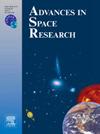2011-2018 年电离层异常发生率的区域特征
IF 2.8
3区 地球科学
Q2 ASTRONOMY & ASTROPHYSICS
引用次数: 0
摘要
本文介绍了根据全球定位系统(GPS)观测数据得出的电离层电子总含量异常发生率的区域特征。我们引入了 27 天移动窗口法来自动检测由各种来源引起的异常。提供了 2011-2018 年极端异常发生率的空间分布、昼夜分布、季节分布和年度分布。正、负异常发生率的空间分布在纬度上有明显的规律,在该区域的某一局部时间内,经度上变化不大。中纬度地区的正负异常出现率与低纬度地区的正负异常出现率在昼夜变化上有明显差异。在北纬 36 度至 45 度地区,正异常出现率的最大值和最小值分别出现在当地时间(LT)17:00 左右和 13:00 左右。2011-2018年,[东经70°-140°,北纬15°-55°]正负异常出现率的季节变化没有明显的规律。2015 年夏季的平均 O/N2 值较低,而其他季节的平均 O/N2 值较高,O/N2 可能不是造成异常出现率季节特征不规则的主要原因。在 F10.7 指数相对较低的年份(如 2018 年),正、负异常发生率可能大于 F10.7 指数相对较大的年份(如 2014 年)。本文章由计算机程序翻译,如有差异,请以英文原文为准。
The regional characteristics of the occurrence rate of ionospheric anomalies in 2011–2018
This paper presents the regional characteristics of the occurrence rate of ionospheric anomalies of total electron content derived from global position system (GPS) observations. The area of concern spans 70° of longitude, from 70° E to 140° E, and 40° of latitude, from 15° N to 55° N. We introduced the 27 days moving window method to automatically detect anomalies that are caused by various sources. The spatial, diurnal, seasonal, and yearly distribution of the occurrence rate of extreme anomalies in 2011–2018 were provided. The spatial distribution of the occurrence rates of positive and negative anomalies had clear patterns in latitude and it did not change much in longitude at a certain local time over this area. The occurrence rates of positive and negative anomalies at the middle latitudes had significantly different diurnal variations from those at low latitudes. The maximum and minimum of the occurrence rates of positive anomalies occurred at about 17:00 local time (LT) and about 13:00 LT over the region from 36° N to 45° N. The maximum and minimum of the occurrence rates of negative anomalies in the same area occurred at about 07:00 LT and 18:00 LT over the region from 36° N to 45° N. There was no clear pattern in the seasonal variations of occurrence rates of positive and negative anomalies over [70° E-140° E, 15° N-55° N] in 2011–2018. The mean O/N2 had low values in summer and comparable high values in other seasons in 2015, and the O/N2 may not be the main reason for irregular seasonal characteristics of occurrence rate of anomalies. The occurrence rates of positive and negative anomaly in the year when the F10.7 index is relatively low, such as 2018, may be larger than the occurrence rates in the year with relatively large F10.7 index, such as 2014.
求助全文
通过发布文献求助,成功后即可免费获取论文全文。
去求助
来源期刊

Advances in Space Research
地学天文-地球科学综合
CiteScore
5.20
自引率
11.50%
发文量
800
审稿时长
5.8 months
期刊介绍:
The COSPAR publication Advances in Space Research (ASR) is an open journal covering all areas of space research including: space studies of the Earth''s surface, meteorology, climate, the Earth-Moon system, planets and small bodies of the solar system, upper atmospheres, ionospheres and magnetospheres of the Earth and planets including reference atmospheres, space plasmas in the solar system, astrophysics from space, materials sciences in space, fundamental physics in space, space debris, space weather, Earth observations of space phenomena, etc.
NB: Please note that manuscripts related to life sciences as related to space are no more accepted for submission to Advances in Space Research. Such manuscripts should now be submitted to the new COSPAR Journal Life Sciences in Space Research (LSSR).
All submissions are reviewed by two scientists in the field. COSPAR is an interdisciplinary scientific organization concerned with the progress of space research on an international scale. Operating under the rules of ICSU, COSPAR ignores political considerations and considers all questions solely from the scientific viewpoint.
 求助内容:
求助内容: 应助结果提醒方式:
应助结果提醒方式:


